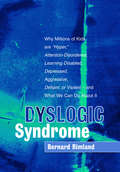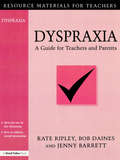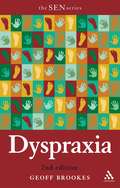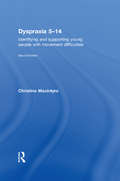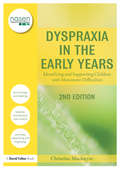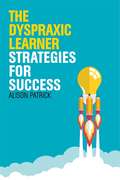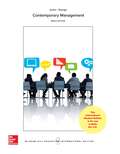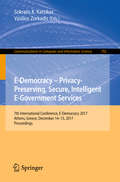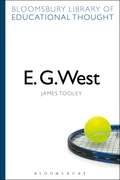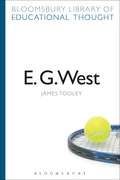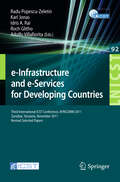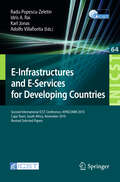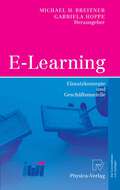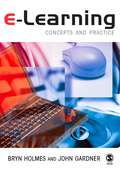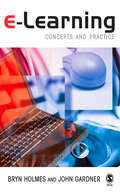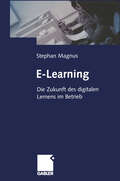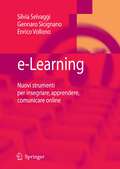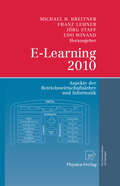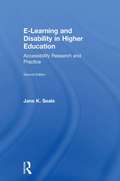- Table View
- List View
Dyslogic Syndrome: Why Millions of Kids are "Hyper," Attention-Disordered, Learning Disabled, Depressed, Aggressive, Defiant, or Violent - and What We Can Do About It
by Bernard RimlandDyslogical children are commonly labelled as having one or more of a mix of conditions that include Attention Deficit/Hyperactivity Disorder, Conduct Disorder, Bipolar Disorder and Oppositional Defiant Disorder. The number of children who could be described as dyslogical continues to rise sharply, and society has a tendency to lay the blame for this trend on poor parenting or bad schooling. In this ground-breaking book, Bernard Rimland argues that such `conventional wisdom' is not just mistaken but dangerous. Drawing on the latest research, Rimland outlines the impact of biological factors on today's children and exposes the influences of toxins and dietary deficiencies. Dyslogic Syndrome is full of valuable advice on the safe, effective treatments that are available to children, and offers positive strategies for helping parents and professionals to do the best for their dyslogical child.
Dyslogic Syndrome: Why Millions of Kids are "Hyper," Attention-Disordered, Learning Disabled, Depressed, Aggressive, Defiant, or Violent - and What We Can Do About It (PDF)
by Bernard RimlandDyslogical children are commonly labelled as having one or more of a mix of conditions that include Attention Deficit/Hyperactivity Disorder, Conduct Disorder, Bipolar Disorder and Oppositional Defiant Disorder. The number of children who could be described as dyslogical continues to rise sharply, and society has a tendency to lay the blame for this trend on poor parenting or bad schooling. In this ground-breaking book, Bernard Rimland argues that such `conventional wisdom' is not just mistaken but dangerous. Drawing on the latest research, Rimland outlines the impact of biological factors on today's children and exposes the influences of toxins and dietary deficiencies. Dyslogic Syndrome is full of valuable advice on the safe, effective treatments that are available to children, and offers positive strategies for helping parents and professionals to do the best for their dyslogical child.
Dyspraxia: A Guide for Teachers and Parents
by Kate Ripley Bob Daines Jenny BarrettThe aim of this text is to promote an understanding of dyspraxia and movement development among professionals who work with children, and also to offer a text which is accessible to parents. It presents a cognitive processing model of dyspraxia from a developmental perspective, and addresses issues of social development in addition to the more easily observable motor planning difficulties which are associated with dyspraxia. The difficulties which may face the dyspraxic child at home and at school are described with strategies for managing their difficulties. Details are provided of the support services available and how they may be accessed.
Dyspraxia: A Guide for Teachers and Parents (Resource Materials For Teachers Ser.)
by Kate Ripley Bob Daines Jenny BarrettThe aim of this text is to promote an understanding of dyspraxia and movement development among professionals who work with children, and also to offer a text which is accessible to parents. It presents a cognitive processing model of dyspraxia from a developmental perspective, and addresses issues of social development in addition to the more easily observable motor planning difficulties which are associated with dyspraxia. The difficulties which may face the dyspraxic child at home and at school are described with strategies for managing their difficulties. Details are provided of the support services available and how they may be accessed.
Dyspraxia 2nd Edition (Special Educational Needs)
by Geoff BrookesUp to ten per cent of the population is believed to suffer from some form of dyspraxia. Accessible and engaging, this practical guide provides teachers with tips and techniques for teaching students with dyspraxia."There are symptoms, there are problems, there are frustrations, there are tears. But there are strategies that can lead to positive outcomes. And while it is important to understand where it comes from, providing support and guidance is what this book is all about." From the introduction This book will prove invaluable reading for everyone who works with young people.This new edition contains new chapters on cures and adolescence.
Dyspraxia 2nd Edition (Special Educational Needs)
by Geoff BrookesUp to ten per cent of the population is believed to suffer from some form of dyspraxia. Accessible and engaging, this practical guide provides teachers with tips and techniques for teaching students with dyspraxia."There are symptoms, there are problems, there are frustrations, there are tears. But there are strategies that can lead to positive outcomes. And while it is important to understand where it comes from, providing support and guidance is what this book is all about." From the introduction This book will prove invaluable reading for everyone who works with young people.This new edition contains new chapters on cures and adolescence.
Dyspraxia 5-14: Identifying and Supporting Young People with Movement Difficulties (nasen spotlight)
by Christine MacintyreDyspraxia is increasingly common in young children. This fully revised and updated edition of Christine Macintyre’s invaluable companion explains the difficulties faced by children with dyspraxia in growing up and offers suggestions as to how these might be alleviated. In this book the children themselves, along with their parents and teachers, talk about how the difficulties change as the transition is made from primary to secondary school. Children with dyspraxia are frequently beset by frustrations as a result of their differences, can be misunderstood both at home and at school, and are very often bullied. This practical guide considers: the issue of giving children labels strategies to reduce stress the value of movement programmes raising self-esteem the transition to secondary school particular challenges faced during Puberty/adolescence handwriting as an indicator of dyspraxia. Including practical activities with additional material for secondary pupils this book shows children how to articulate their differences using individualised explanations, and then go on to succeed having recognised where their talents lie. Dyspraxia 5-14 is essential reading for teachers, parents, SENCos, teaching assistants and trainee teachers who want to improve their understanding of dyspraxia and its implications for children in Key stages 1-3.
Dyspraxia 5-14: Identifying and Supporting Young People with Movement Difficulties (nasen spotlight)
by Christine MacintyreDyspraxia is increasingly common in young children. This fully revised and updated edition of Christine Macintyre’s invaluable companion explains the difficulties faced by children with dyspraxia in growing up and offers suggestions as to how these might be alleviated. In this book the children themselves, along with their parents and teachers, talk about how the difficulties change as the transition is made from primary to secondary school. Children with dyspraxia are frequently beset by frustrations as a result of their differences, can be misunderstood both at home and at school, and are very often bullied. This practical guide considers: the issue of giving children labels strategies to reduce stress the value of movement programmes raising self-esteem the transition to secondary school particular challenges faced during Puberty/adolescence handwriting as an indicator of dyspraxia. Including practical activities with additional material for secondary pupils this book shows children how to articulate their differences using individualised explanations, and then go on to succeed having recognised where their talents lie. Dyspraxia 5-14 is essential reading for teachers, parents, SENCos, teaching assistants and trainee teachers who want to improve their understanding of dyspraxia and its implications for children in Key stages 1-3.
Dyspraxia in the Early Years: Identifying and Supporting Children with Movement Difficulties (nasen spotlight)
by Christine MacintyreToday there are more children than ever before in need of a variety of additional support needs, and many of these children have poor movement as a key contributory factor. Even in children with no specific ‘label’, movement is being found to be linked to learning, and educational professionals need to understand what is amiss and how to support children who do not meet their motor milestones at the correct time. The brand new topic areas featured in this comprehensive and practical new edition include: a discussion of terminology and labelling (in light of current inclusion guidelines) a range of age specific activities a section on the neurology of dyspraxia, showing the motor pathways that are energised and define motor competence a greater emphasis on balance, coordination and control examples from children of how movement is dependent on planning, sequencing and organising more practical activities that can form the basis of a programme to support the children. Practical strategies are provided throughout this authoritative book, so that teachers and other professionals can identify and understand movement difficulties, are empowered to support the children, and work effectively with the parents.
Dyspraxia in the Early Years: Identifying and Supporting Children with Movement Difficulties (nasen spotlight)
by Christine MacintyreToday there are more children than ever before in need of a variety of additional support needs, and many of these children have poor movement as a key contributory factor. Even in children with no specific ‘label’, movement is being found to be linked to learning, and educational professionals need to understand what is amiss and how to support children who do not meet their motor milestones at the correct time. The brand new topic areas featured in this comprehensive and practical new edition include: a discussion of terminology and labelling (in light of current inclusion guidelines) a range of age specific activities a section on the neurology of dyspraxia, showing the motor pathways that are energised and define motor competence a greater emphasis on balance, coordination and control examples from children of how movement is dependent on planning, sequencing and organising more practical activities that can form the basis of a programme to support the children. Practical strategies are provided throughout this authoritative book, so that teachers and other professionals can identify and understand movement difficulties, are empowered to support the children, and work effectively with the parents.
The Dyspraxic Learner: Strategies for Success
by Alison PatrickWith a wealth of practical strategies for teaching and supporting students with dyspraxia aged from 11 years up to college or university level, this book addresses all aspects of learning and ways in which teaching can be tailored to the dyspraxic learner. By exploring dyspraxia and its physical, emotional, psychological and social impacts on learning, the author shares tried-and-tested strategies for ensuring that students with dyspraxia achieve their full potential. This book covers a wide range of topics, such as research and study skills, improving memory, teaching literacy, visual and auditory learning styles, dealing with sleeplessness, stress, low self-esteem and anxiety, and preparing for future employment. Teachers will have a greater understanding of dyspraxia, and feel confident in helping students with dyspraxia to overcome educational challenges. Teachers, lecturers, tutors and SENCOs will find this book useful, and it will also be of interest to students with dyspraxia who are looking for ways to help themselves with their school or university work.
The Dyspraxic Learner: Strategies for Success (PDF)
by Alison PatrickWith a wealth of practical strategies for teaching and supporting students with dyspraxia aged from 11 years up to college or university level, this book addresses all aspects of learning and ways in which teaching can be tailored to the dyspraxic learner. By exploring dyspraxia and its physical, emotional, psychological and social impacts on learning, the author shares tried-and-tested strategies for ensuring that students with dyspraxia achieve their full potential. This book covers a wide range of topics, such as research and study skills, improving memory, teaching literacy, visual and auditory learning styles, dealing with sleeplessness, stress, low self-esteem and anxiety, and preparing for future employment. Teachers will have a greater understanding of dyspraxia, and feel confident in helping students with dyspraxia to overcome educational challenges. Teachers, lecturers, tutors and SENCOs will find this book useful, and it will also be of interest to students with dyspraxia who are looking for ways to help themselves with their school or university work.
E-book: Contemporary Management (UK Higher Education Business Management)
by JonesE-book: Contemporary Management
E-Democracy – Privacy-Preserving, Secure, Intelligent E-Government Services: 7th International Conference, E-Democracy 2017, Athens, Greece, December 14-15, 2017, Proceedings (Communications in Computer and Information Science #792)
by Sokratis K. Katsikas Vasilios ZorkadisThis book constitutes the refereed proceedings of the 7th International Conference on E-Democracy, E-Democracy 2017, held in Athens, Greece, in December 2017.The 18 revised full papers presented were carefully selected from 44 submissions. The papers are organized in topical sections on e-democracy; privacy; information dissemination and freedom of expression; social networks; electronic identity authentication; ICT in government and in the economy.
E. G. West: Economic Liberalism And The Role Of Government In Education (Bloomsbury Library of Educational Thought)
by James TooleyWhat role should government have in education? This question has exercised philosophers since Plato and economists since Adam Smith. It is also a question that is as relevant today, as people around the world worry about standards in public (government) schools and governments and international agencies look to fine-tune their educational policies.This book describes and analyses the work of one economist, Professor E.G. West, whose life's work was focused precisely on this question. His classic 1965 book, Education and the State, and subsequent writings inspired a new way of looking at this question. Based on historical analysis of what happened in the UK and USA before governments got involved in education, and supplemented with philosophical exploration of the justifications for government involvement, West set out a position with only minimal state involvement.James Tooley outlines West's ideas and their challenges, elaborating them in terms of public choice theory and recent empirical evidence of 'education without the state' in developing countries.
E. G. West: Economic Liberalism And The Role Of Government In Education (Continuum Library of Educational Thought)
by James Tooley Richard BaileyWhat role should government have in education? This question has exercised philosophers since Plato and economists since Adam Smith. It is also a question that is as relevant today, as people around the world worry about standards in public (government) schools and governments and international agencies look to fine-tune their educational policies.This book describes and analyses the work of one economist, Professor E.G. West, whose life's work was focused precisely on this question. His classic 1965 book, Education and the State, and subsequent writings inspired a new way of looking at this question. Based on historical analysis of what happened in the UK and USA before governments got involved in education, and supplemented with philosophical exploration of the justifications for government involvement, West set out a position with only minimal state involvement.James Tooley outlines West's ideas and their challenges, elaborating them in terms of public choice theory and recent empirical evidence of 'education without the state' in developing countries.
e-Infrastructure and e-Services for Developing Countries: Third International ICST Conference, AFRICOMM 2011, Zanzibar, Tansania, November 23-24, 2011, Revised Selected Papers (Lecture Notes of the Institute for Computer Sciences, Social Informatics and Telecommunications Engineering #92)
by Radu Popescu-Zeletin Karl Jonas Idris A. Rai Roch Glitho Adolfo VillafioritaThis book constitutes the thoroughly refereed post-conference proceedings of the Third International ICST Conference on e-Infrastructure and e-Services for Developing Countries, AFRICOMM 2011, held in Zanzibar, Tansania, in November 2011. The 24 revised full papers presented together with 2 poster papers were carefully reviewed and selected from numerous submissions. The papers cover a wide range of topics in the field of information and communication infrastructures. They are organized in two tracks: communication infrastructures for developing countries and electronic services, ICT policy, and regulatory issues for developing countries.
E-Infrastructure and E-Services for Developing Countries: Second International ICST Conference, AFRICOM 2010, Cape Town, South Africa, November 25-26, 2010, Revised Selected Papers (Lecture Notes of the Institute for Computer Sciences, Social Informatics and Telecommunications Engineering #64)
by Radu Popescu-Zeletin Idris A. Rai Karl Jonas Adolfo VillafioritaThis book constitutes the thoroughly refereed post-conference proceedings of the Second International ICST Conference on e-Infrastructure and e-Services for Developing Countries, AFRICOM 2010, held in Cape Town, South Africa, in November 2010. The 13 revised full papers presented were carefully reviewed and selected and cover a wide range of topics such as wireless network technologies, E-governance, as well as ICT for development and ICT business models and open-access.
E-Learning: Einsatzkonzepte und Geschäftsmodelle
by Michael Breitner Gabriela HoppeDer vorliegende Band ist dem Lernen und Lehren auf der Basis moderner Informations- und Kommunikationstechnologien gewidmet. Das Buch fasst die wichtigsten Ansätze zur Einführung, Umsetzung und Evaluation von E-Learning zusammen. Es geht zum einen um die Frage nach sinnvollen Konzepten für den Einsatz von Electronic- und Mobile-Learning. Die Beiträge behandeln Fragen der Auswahl, Einführung und Ausgestaltung von E-Learning-Systemen. Dabei werden pädagogische, technische und wirtschaftliche Aspekte im Zusammenhang gesehen. Zum anderen sind erfolgreiche Geschäftsmodelle in der öffentlichen und privaten Fort- und Weiterbildung immer wichtiger. Dabei geht es genauso um die Frage des geeigneten Business-Plans wie um das Qualitätsmanagement und die Sicherstellung der langfristigen Nachhaltigkeit und Effizienz von E-Learning-Anwendungen. Neben wissenschaftlichen Beiträgen zeigen zahlreiche Beiträge von Praktikern beispielhaft mögliche Umsetzungsstrategien.
E-Learning: Concepts and Practice (PDF)
by John Gardner Bryn Holmese-Learning is now an essential component of education. Globalization, the proliferation of information available on the Internet and the importance of knowledge-based economies have added a whole new dimension to teaching and learning. As more tutors, students and trainees, and institutions adopt online learning there is a need for resources that will examine and inform this field. Using examples from around the world, the authors of e-Learning: Concepts and Practices provide an in-depth examination of past, present and future e-learning approaches, and explore the implications of applying e-learning in practice. Topics include: - educational evolution - enriching the learning experience - learner empowerment - design concepts and considerations - creation of e-communities - communal constructivism This book is essential reading for anyone involved in technology enhanced learning systems, whether an expert or coming new to the area. It will be of particular relevance to those involved in teaching or studying for information technology in education degrees, in training through e-learning courses and with developing e-learning resources. Bryn Holmes is an assistant professor in Education at Concordia University, Montreal and director of an Internet company, Inishnet, which offers research and consultancy in online education. John Gardner is a professor of education at Queen's University, Belfast and his main research areas include policy and practice in information and communications technology in education.
E-Learning: Concepts and Practice
by Bryn Holmes John Gardnere-Learning is now an essential component of education. Globalization, the proliferation of information available on the Internet and the importance of knowledge-based economies have added a whole new dimension to teaching and learning. As more tutors, students and trainees, and institutions adopt online learning there is a need for resources that will examine and inform this field. Using examples from around the world, the authors of e-Learning: Concepts and Practices provide an in-depth examination of past, present and future e-learning approaches, and explore the implications of applying e-learning in practice. Topics include: - educational evolution - enriching the learning experience - learner empowerment - design concepts and considerations - creation of e-communities - communal constructivism This book is essential reading for anyone involved in technology enhanced learning systems, whether an expert or coming new to the area. It will be of particular relevance to those involved in teaching or studying for information technology in education degrees, in training through e-learning courses and with developing e-learning resources. Bryn Holmes is an assistant professor in Education at Concordia University, Montreal and director of an Internet company, Inishnet, which offers research and consultancy in online education. John Gardner is a professor of education at Queen's University, Belfast and his main research areas include policy and practice in information and communications technology in education.
E-Learning: Die Zukunft des digitalen Lernens im Betrieb
by Stephan MagnusDigitale Ansätze müssen klassische Methoden der Wissensvermittlung ergänzen. Der Autor behandelt mögliche innerbetriebliche Felder des E-Learning. Vorschläge zum Aufbau von Lernteams, Qualifizierungsprogrammen, digitalen Zukunftswerkstätten oder Virtual Corporate Universities runden das Buch ab.
e-Learning: Nuovi strumenti per insegnare, apprendere, comunicare online
by Silvia Selvaggi Gennaro Sicignano Enrico VollonoQuesto volume offre una panoramica sull’evoluzione della formazione in rete, ponendo l’attenzione sia sulle possibili trasformazioni operate dalle nuove tecnologie sulla didattica, sia sull’aspetto più squisitamente tecnico, attraverso l’analisi dei sistemi per la formazione online. Lo scopo è quello di avvicinare all’e-learning docenti, studenti e chiunque abbia intenzione di saperne di più su un argomento che, per molti versi, resta ancora sconosciuto alla maggior parte di coloro che operano nel mondo della formazione. Si intende fornire, cioè, la possibilità di entrare in contatto con le innumerevoli opportunità che le nuove tecnologie offrono per trasformare, migliorare e rendere più accessibile l’insegnamento e l’apprendimento, con uno sguardo alle prospettive future di un settore che si presenta in continua evoluzione.
E-Learning 2010: Aspekte der Betriebswirtschaftslehre und Informatik
by Michael H. Breitner Franz Lehner Jörg Staff Udo WinandTechnologiebasiertes und mobiles Lernen und Lehren sind in der Informations- und Wissensgesellschaft von zentraler Bedeutung. Ziel des Sammelbandes ist es, einen Blick in die nahe Zukunft des E- und M-Learnings zu werfen: der lebenslangen Aus- und Weiterbildung vom Vorschul- bis ins Rentenalter unter Verwendung von Rechnern und Rechnernetzwerken. Bei der Entwicklung solcher Angebote kommt es vor allem darauf an, ganzheitliche, integrierte Ansätze zu finden, die die drei Säulen Technologie, Didaktik und Betriebswirtschaftslehre berücksichtigen.
E-learning and Disability in Higher Education: Accessibility Research and Practice
by Jane K. SealeMost people working within the higher education sector understand the importance of making e-learning accessible to students with disabilities, yet it is not always clear exactly how this should be accomplished. E-Learning and Disability in Higher Education evaluates current accessibility practice and critiques the extent to which 'best' practices can be confidently identified and disseminated. This second edition has been fully updated and includes a focus on research that seeks to give 'voice' to disabled students in a way that provides an indispensible insight into their relationship with technologies and the institutions in which they study. Examining the social, educational, and political background behind making online learning accessible in higher and further education, E-Learning and Disability in Higher Education considers the roles and perspectives of the key stake-holders involved in e-learning: lecturers, professors, instructional designers, learning technologists, student support services, staff developers, and senior managers and administrators.
